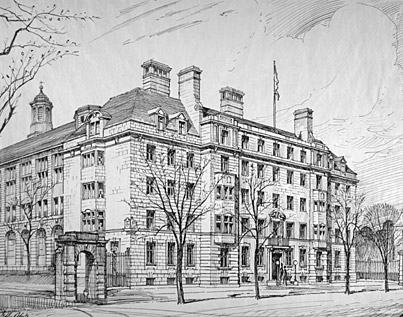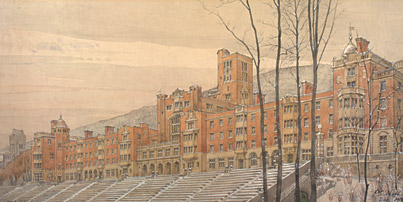The campus that never was (Page 3)
The campus that never was (Page 3) McGill University
User Tools (skip):
The campus that never was (Page 3)
Douglas Hall without the walk

The lack of a gymnasium and residences vexed the University for decades -- the need for a men's residence was first pointed out in 1882. Numerous sites were proposed for the structures, and Nobbs came up with building ideas for each of them, including on University where the Montreal Neurological Institute stands today, and another on McTavish on land now occupied by the McGill Bookstore.
Both the residence project and the gym received a boost in the First World War. James Douglas donated $115,000 for a men's residence, which, with $100,000 that was supposed to come from the federal government for officer training space in the proposed gymnasium, could form a solid financial basis for the new structures. In 1919, Nobbs drew up plans for two sites under consideration by the Board of Governors. One would stand roughly where the Otto Maass Building and Pulp and Paper Research Institute are, the other would have faced onto Sherbrooke in the same corner of lower campus. Both were plans that would have seen the residences (then for men only) and gymnasium constructed as adjoining buildings. The plan also called for a separate gym entrance for women.
Drummond says this was a very typical Nobbs building, pointing to the chimneys and towers that decorate the top of the structure. Also, Nobbs's signature "lines" along the first floor and below the roof accentuate the building's structure.
"Again, it's blocking campus from the city. It's a drama-tic change from the concept of an open campus."
The University eventually decided the space could be better used for academic buildings.
Douglas Hall with a view

A third site for Douglas Hall might have sharply cut down on attendance at football games. Why leave your cozy residence room when all you need to do to see the game is open the curtains?
The land for the current residences, gymnasium and stadium was part of a prescient purchase by Sir William Macdonald, McGill's greatest benefactor. "Macdonald Park" was given to the University in 1911, and Nobbs designed a few facades for a residence that would sit to the north of the stadium.
Drummond quite likes Nobbs's concept for this residence. The building shown here would have afforded glorious views of the playing field and the city beyond.
"But we wouldn't have been able to extend the stadium," he points out.
In the end, the federal government did not come through with its portion for the gym, and the Douglas donation was not enough on its own to cover the whole cost of the residence. A more modest Douglas Hall would not be built until 1936. The gym would follow three years later, after dogged fundraising by the Graduates' Society.


